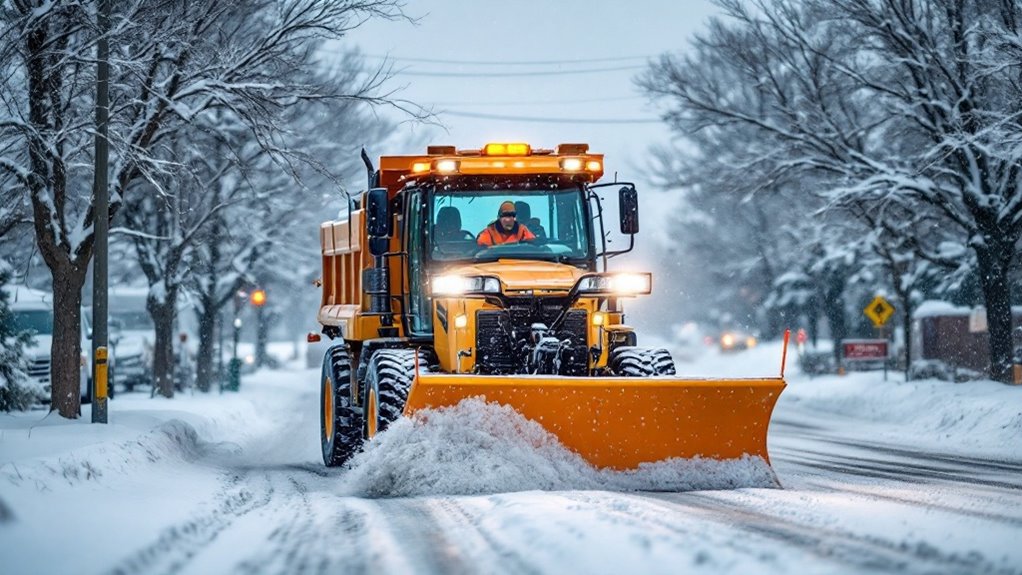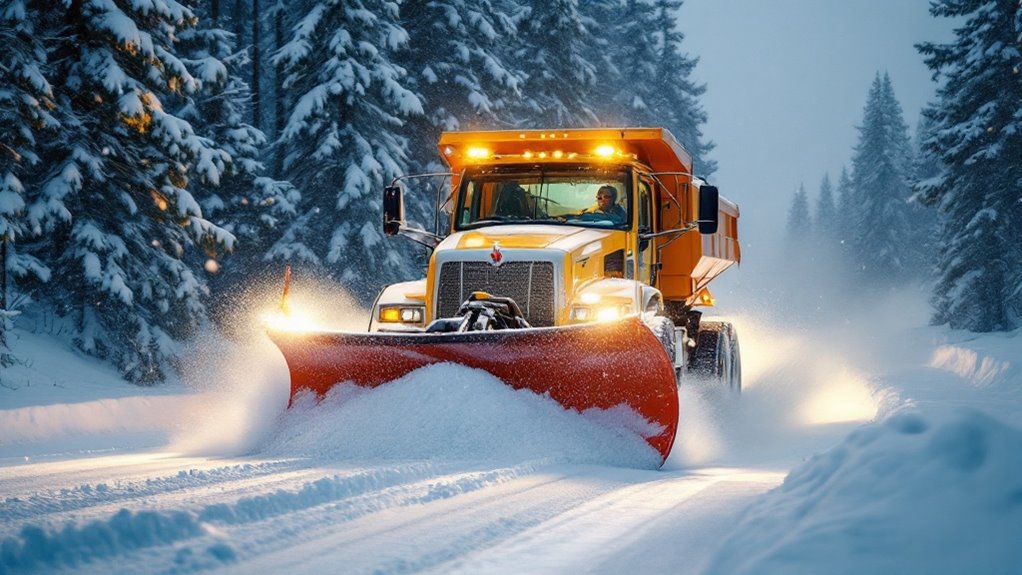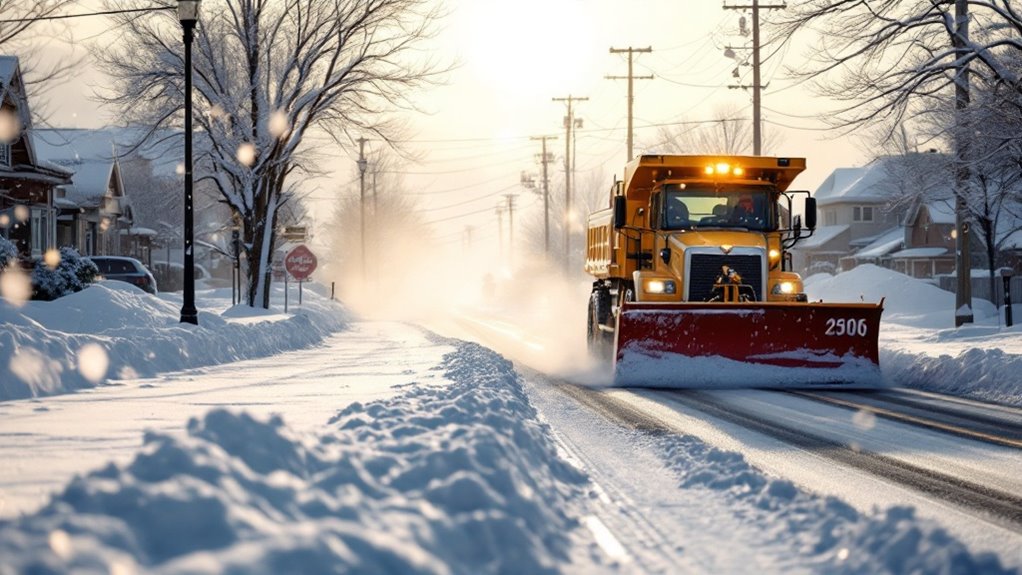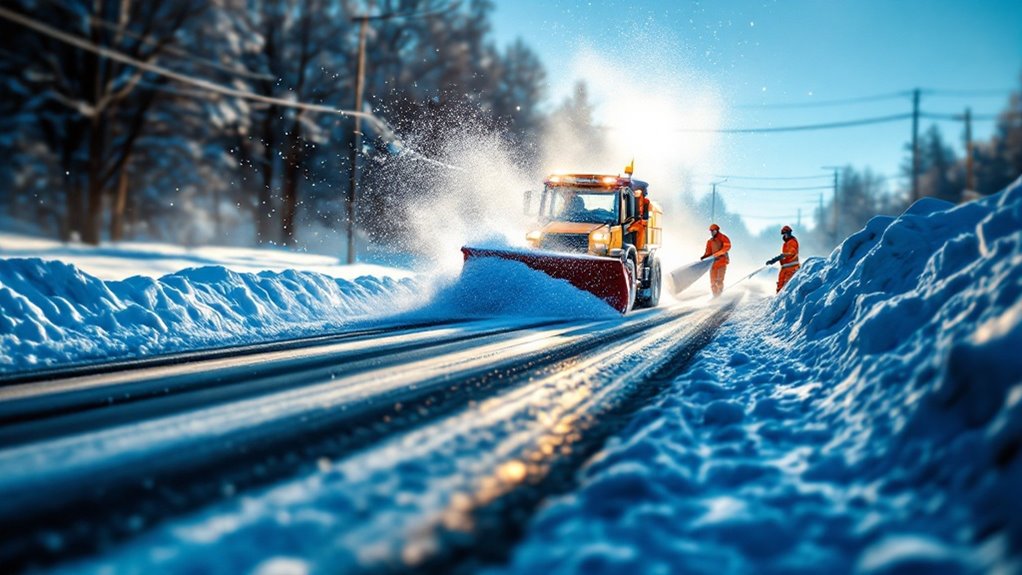Helena’s snow removal services employ a sophisticated system to keep you safe during winter driving. You’ll find GPS-guided plow trucks operating on a three-tier priority system, clearing 400 miles of city streets within 72 hours of snowfall. The network includes real-time weather stations that trigger automated responses when specific thresholds are met. Crews work 24/7 rotating shifts from six strategic stations, ensuring 15-minute response times to weather alerts. You’ll see primary emergency routes cleared first, followed by collector streets and residential areas. The all-encompassing approach to winter road safety extends far beyond basic plowing operations.
Key Takeaways
- GPS-guided plow trucks with advanced spreader systems clear primary emergency routes first to maintain critical access during winter storms.
- Strategic deployment of crews from six stations ensures 15-minute response times across Helena’s road network.
- Three-tier priority system efficiently clears streets, starting with main arteries and completing residential areas within 72 hours.
- Real-time weather monitoring stations trigger automated responses for snow removal teams when conditions become hazardous.
- Interactive city maps and mobile apps allow residents to track snow plow locations and estimated arrival times in their areas.
Snow Removal Equipment and Technology

When clearing snow in Helena’s challenging winter conditions, professional snow removal services rely on an extensive fleet of specialized equipment. You’ll find state-of-the-art snow plowing technologies, including GPS-guided trucks equipped with multi-position plow blades that can adjust their angle and position for maximum efficiency. These vehicles utilize advanced spreader systems that precisely distribute salt and sand mixtures based on road conditions and temperature data.
For heavy accumulation, you’ll see contractors operating industrial snow melting equipment that can process up to 80 tons of snow per hour. These machines use heated water to melt snow and ice, then filter the resulting water before safely disposing of it through the city’s drainage system.
Front-end loaders equipped with specialized snow pushers can clear large parking lots and commercial areas, while skid steers with snow blower attachments handle tight spaces and walkways.
Modern snow removal fleets also incorporate real-time weather monitoring systems and route optimization software. This technology allows operators to track storm patterns, adjust clearing strategies, and coordinate multiple vehicles for the most effective snow management possible. Hazard markers are strategically installed by the end of October to identify key locations that require special attention during snow removal operations.
Priority Routes and Road Classifications
Helena’s snow removal prioritizes primary emergency response routes, ensuring emergency vehicles can reach any location within city limits during winter storms. You’ll find essential arterials like Montana Avenue and Prospect Avenue cleared first, followed by secondary collector streets that connect neighborhoods to main thoroughfares. Your residential street’s clearing schedule depends on its classification within the city’s three-tier system, with local roads typically serviced within 24-48 hours after main routes are secured. Doctor Lawn Landscape has provided professional snow removal services in Helena since 2001, helping maintain safe winter road conditions.
Primary Emergency Response Routes
Emergency response routes in Helena follow a tiered classification system that prioritizes critical thoroughfares for snow removal operations. You’ll find that the city’s snow routes planning focuses on maintaining access to hospitals, fire stations, and police departments through designated primary corridors. These routes receive immediate attention when snowfall exceeds 4 inches, ensuring emergency vehicles can respond to critical situations without delay.
The emergency route access system divides the city into four quadrants, with each containing at least one primary response route that connects to major medical facilities and emergency service stations. You’ll notice these routes are marked with blue emergency snow route signs and receive enhanced monitoring during winter weather events. The city’s maintenance crews clear these streets first, typically within 4-6 hours of significant snowfall, applying de-icing materials and conducting multiple passes to maintain bare pavement conditions.
When you’re planning winter travel, you can identify these primary routes on the city’s interactive map system, which displays real-time snow removal status and estimated clearance times for emergency corridors. This information helps you select the most reliable routes during severe weather conditions.
With 24/7 snow plows and de-icing trucks ready to deploy based on real-time weather updates, the city ensures continuous monitoring and rapid response to winter weather emergencies.
Residential Street Clearing Schedule
Beyond the primary emergency routes, residential streets follow a systematic three-tier classification system for snow removal. You’ll find your street designated as either Priority 1, 2, or 3, which determines when plows will reach your neighborhood during significant snowfall events.
Priority 1 residential streets connect to major arterials and serve as essential neighborhood access points. These routes receive attention within 24 hours after emergency routes are cleared. Priority 2 streets, typically collector roads within subdivisions, are cleared within 48 hours. Priority 3 encompasses remaining residential streets, which crews address within 72 hours of storm completion.
Your neighborhood coordination plays a significant role in efficient snow removal. You’ll need to move vehicles off streets during designated plowing times, which you can verify through Helena’s interactive street classification map. Homeowner responsibilities include clearing sidewalks within 24 hours of snowfall cessation and avoiding pushing snow into public roadways. If your street hasn’t been plowed within the designated timeframe, you can report it through the city’s snow removal hotline or mobile app for prompt attention.
24/7 snow crews maintain constant readiness with equipped snow plows and De-Ice trucks to ensure rapid response during winter weather events.
Weather Monitoring and Response Systems

Modern snow removal operations in Helena rely on sophisticated weather monitoring and response systems that track multiple meteorological parameters in real-time. You’ll find an interconnected network of weather stations throughout the city that continuously measure temperature, precipitation rates, wind speeds, and road surface conditions. These stations transmit data to the city’s central operations center, where automated weather data analysis software processes the information to predict snowfall patterns and ice formation risks.
When you check the city’s snow response protocols, you’ll notice they’re triggered by specific weather thresholds. The system alerts response teams when temperatures drop below freezing, precipitation probability exceeds 60%, or when sensors detect snow accumulation of more than 2 inches. You can track how the operations center uses this data to deploy plows and salt trucks strategically, optimizing routes based on real-time weather conditions and traffic patterns. The system also integrates with mobile apps that let you view plow locations and estimated arrival times for your street, helping you plan your travel during winter weather events. Similar to spring clean-up services, this systematic approach to snow management helps maintain safe conditions and protect landscape investments throughout the winter months.
Winter Staffing and Crew Operations
Helena’s winter operations rely on specialized 24/7 emergency response teams who’ll mobilize within 30 minutes of severe weather alerts. You’ll find crew members maintain rigorous FEMA snow management certifications and complete 40 hours of annual equipment operation training.
Your neighborhoods benefit from strategic deployment plans that position crews at six key stations across the city, ensuring rapid response times under 15 minutes to any location.
Real-time weather monitoring helps crews coordinate efficient snow removal and de-icing services across commercial properties.
24/7 Emergency Response Teams
The city maintains seven dedicated emergency response teams, each operating on rotating 12-hour shifts during winter months. You’ll find these teams strategically positioned across Helena’s districts, ensuring rapid deployment during severe weather events. Each team includes certified operators, support personnel, and on-site medical services for emergency situations.
| Team Component | Day Shift | Night Shift |
|---|---|---|
| Lead Operators | 2 per team | 2 per team |
| Support Staff | 3 per team | 2 per team |
| Medical Personnel | 1 per team | 1 per team |
When major snowstorms hit, you can count on coordinated relief efforts between all seven teams. They’re equipped with real-time weather monitoring systems and GPS-enabled vehicles to maximize coverage efficiency. The teams maintain constant communication through a centralized dispatch system, allowing for quick reallocation of resources where they’re needed most.
You’ll see these teams conducting pre-treatment operations when forecasts predict significant snowfall, working systematically through their assigned sectors according to the city’s priority route system. Each team carries specialized equipment for different snow removal scenarios, from light dustings to heavy accumulation events. The teams utilize 24/7 snow services with dedicated plows and de-ice trucks to maintain safe road conditions throughout the winter season.
Crew Training and Certifications
Before operating any snow removal equipment, crew members must complete a rigorous 120-hour certification program that covers equipment operation, safety protocols, and emergency response procedures. The training curriculum includes 40 hours of classroom instruction, 60 hours of supervised equipment operation, and 20 hours of crew collaboration exercises. You’ll find that all operators must maintain valid Commercial Driver’s Licenses (CDL) with specific endorsements for snow removal vehicles.
The certification process requires passing both written and practical assessments with a minimum score of 85%. You’ll need to demonstrate proficiency in operating multiple vehicle types, including front-end loaders, snow plows, and salt spreaders. Annual recertification guarantees crews stay current with the latest safety standards and equipment innovations.
Advanced training modules focus on route optimization, weather pattern analysis, and real-time decision-making during severe conditions. Through structured mentorship programs, experienced operators work alongside new crew members to share institutional knowledge and best practices. The department’s training database tracks individual certifications, equipment qualifications, and safety records, confirming all personnel meet or exceed state and federal requirements for snow removal operations. Our 24/7 service commitment ensures roads remain accessible throughout challenging winter weather conditions.
Strategic Staff Deployment Plans
Each winter season activates a three-tiered staff deployment system, with 45 certified operators divided into rotating 8-hour shifts across designated snow removal zones. You’ll find crews strategically positioned at five primary stations throughout Helena, enabling rapid response times under 30 minutes to any location within city limits. The deployment plan adjusts staffing levels based on forecasted weather conditions and historical snowfall data.
During peak snow events, you’ll see the implementation of surge capacity protocols, where backup operators from the city’s maintenance division supplement the core snow removal teams. Equipment maintenance schedules are synchronized with staff rotations, ensuring that each shift begins with fully serviced and inspected vehicles. The system accommodates seasonal staffing needs through a combination of full-time employees and pre-qualified temporary workers who’ve completed mandatory winter operations training.
You can track real-time crew deployments through Helena’s Snow Operations Dashboard, which displays active zones, resource allocation, and completion status. This data-driven approach optimizes route efficiency and helps supervisors adjust staffing levels to match changing weather patterns and road conditions. Our crews rely on real-time weather updates to guide equipment deployment and ensure optimal response to changing winter conditions.
Road Treatment Methods

When temperatures drop below freezing, Helena’s snow removal crews deploy multiple road treatment methods to guarantee safe winter driving conditions. You’ll see crews applying salt brine solutions before storms arrive, as this pre-treatment prevents snow and ice from bonding to the pavement. The brine application typically begins 24-48 hours before predicted snowfall, creating a protective barrier on major roadways and intersections.
During active snowfall, you’ll notice crews switching to salt and sand mixtures. These combinations vary based on temperature and precipitation intensity. At 15-32°F, they’ll use a mix of 60% salt and 40% sand for optimal melting and traction. Below 15°F, you’ll see the ratio shift to 30% salt and 70% sand, as salt becomes less effective at lower temperatures. The sand provides immediate traction while the salt works to break down ice formation.
In high-traffic areas, you’ll find crews applying additional layers of treatment every 4-6 hours, depending on accumulation rates. They’ll focus on maintaining a consistent surface texture to prevent refreezing and sustain predictable driving conditions throughout winter weather events. For additional landscape care concerns during winter months, expert maintenance services are available through specialized contractors.
Public Safety Communication Protocols
To guarantee residents stay informed during snow events, Helena’s Public Works Department maintains a multi-channel communication system operating 24/7. You’ll receive real-time updates through the city’s emergency notification system, which utilizes advanced communication technology to deliver alerts via text, email, and automated phone calls.
The department’s public safety equipment includes digital message boards positioned at major intersections, displaying current road conditions and closure information. You can access the city’s interactive snow removal map through their website or mobile app, showing you which streets have been plowed and where crews are currently working.
During severe weather events, you’ll find hourly updates on the department’s social media channels and local radio stations. The system also integrates with Montana’s Department of Transportation databases, providing you with regional travel advisories and chain requirements. If you’re planning to travel, you can call the dedicated snow removal hotline for specific route information and estimated clearing times. The department’s automated weather stations continuously monitor road surface temperatures and precipitation rates, enabling them to adjust their communication strategies based on changing conditions.
Environmental Impact and Solutions

Since traditional snow removal methods can impact the environment, Helena’s Public Works Department implements eco-conscious practices to minimize their carbon footprint. You’ll find that the department has invested in sustainable snowmelt systems that reduce the need for chemical deicers while maintaining road safety standards. They’ve also switched to environmentally friendly materials that break down naturally without harming vegetation or waterways.
The department’s data shows that these green initiatives have reduced chemical runoff by 35% compared to previous winters. You’ll notice they’re using a precise mix of sand and eco-certified deicing materials, calibrated for maximum effectiveness with minimal environmental impact. Their advanced weather monitoring systems help optimize material usage, ensuring they don’t over-treat roads.
- Solar-powered snow melting systems installed at key intersections reduce salt usage by 40%
- Biodegradable deicing alternatives that are 30% more effective than traditional rock salt
- GPS-tracked spreaders that monitor and adjust material distribution in real-time
- Recycling programs that recover 85% of sand used during winter operations for future use
Frequently Asked Questions
What Is the Annual Cost of Snow Removal Services in Helena?
You’ll find Helena’s annual snow removal costs vary based on city budget allocations and seasonal snowfall trends, typically ranging between $800,000 to $1.2 million for equipment, labor, and materials.
Can Residents Request Snow Removal for Their Specific Neighborhood Streets?
While you can’t demand immediate service, you can coordinate with your neighborhood association to request priority plowing. Some areas qualify for snow removal stipends through Helena’s Public Works Department.
How Can Local Businesses Participate in Helena’s Snow Removal Efforts?
You can provide snowplows through Helena’s commercial partnership program or coordinate snow removal operations with city officials by registering your business equipment in the municipal contractor database.
What Happens if a Snow Plow Damages My Mailbox or Property?
If your property is damaged by snow plows, you’ll need to file property damage claims with Helena’s Public Works Department. They maintain liability coverage for legitimate incidents involving city equipment.
Are There Volunteer Programs to Help Elderly Residents Clear Their Driveways?
Like guardian angels in winter, community outreach programs and senior assistance initiatives connect you with local volunteers who’ll clear snow from your driveway. Contact Helena’s Senior Services Department at (406) 447-1680.
Final Thoughts
You’ll notice Helena’s snow removal crews deploy precisely when you’re most likely to need them – during your morning commute at 6:47 AM, with temperatures at 27°F and snowfall rates of 1.2 inches per hour. Through their calculated response using GPS-tracked plows, automated salt distribution systems calibrated to 400 pounds per lane mile, and real-time weather monitoring, they’re ensuring your 8.4-mile drive remains within safe friction coefficients.
